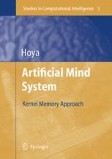Search
Search Results
-
The Kernel Memory Concept – A Paradigm Shift from Conventional Connectionism
In this chapter, the general concept of kernel memory (KM) is described, which is given as the basis for not only representing the general notion of...
-
Modelling Abstract Notions Relevant to the Mind and the Associated Modules
This chapter is devoted to the remaining four modules within the AMS, i.e. 1) attention, 2) emotion, 3) intention, and 4) intuition module, and their...
-
Introduction
Genetic algorithms (GAs) are powerful search techniques based on principles of evolution. They are now widely applied to solve problems in many...
-
Linkage Learning Genetic Algorithm
In order to handle linkage evolution and to tackle the ordering problem, Harik [47] took Holland’s call [53] for the evolution of tight linkage quite...
-
Preliminaries: Assumptions and the Test Problem
After introducing the background and motivation of the linkage learning genetic algorithm, we will start to improve and understand the linkage...
-
From Classical Connectionist Models to Probabilistic/Generalised Regression Neural Networks (PNNs/GRNNs)
This chapter begins by briefly summarising some of the well-known classical connectionist/artificial neural network models such as multi-layered...
-
Language and Thinking Modules
In this chapter, we focus upon the two modules which are closely tied to the concept of “action planning”, i.e. the 1) language and 2) thinking...
-
Sensation and Perception Modules
In any kind of creature, both the mechanisms of sensation and perception are indispensable for continuous living, e.g. to find edible plants/fruits...
-
Content Based Image Compression in Biomedical High-Throughput Screening Using Artificial Neural Networks
Biomedical High-Throughput Screening (HTS) requires specific properties of image compression. Particularly especially when archiving a huge number of...
-
Discriminative Clustering of Yeast Stress Response
When a yeast cell is challenged by a rapid change in the conditions, be it temperature, osmolarity, pH, nutrient or other, it starts a genome stress...
-
Medical Bioinformatics: Detecting Molecular Diseases with Case-Based Reasoning
Based on the Human Genome Project, the new interdisciplinary subject of bioinformatics has become an important research topic during the last decade....
-
Cancer Classification with Microarray Data Using Support Vector Machines
Microarrays (Schena et al. 1995) are also called gene chips or DNA chips. On a microarray chip, there are thousands of spots. Each spot contains the...
-
Random Voronoi Ensembles for Gene Selection in DNA Microarray Data
Currently, cancer and other complex pathologies are analyzed mainly by morphological classification. In the past few decades there have been dramatic...
-
Class Prediction with Microarray Datasets
Microarray technology is having a significant impact in the biological and medical sciences and class prediction will play an increasingly important...
-
Genetic Algorithms Based Hybrid Intelligent Systems
The oldest branch of Evolutionary Computation, namely GA, is at the same time the used in real-world applications of HIS. Chapter 8 of the book tries...
-
New Trends of Develo** Hybrid Intelligent Systems – AIS Hybridization and DNA-Hybridization
As already mentioned in Chap.1, the use of biologically inspired CI techniques play a crucial role for the hybridisation at any level of HIS features...
-
The Artificial Mind System (AMS), Modules, and Their Interactions
The previous two chapters have been devoted to establishing the novel artificial neural network concept, namely the kernel memory concept, for the...
-
Genetic Algorithms and Genetic Linkage
This chapter provides a summary of fundamental materials on genetic algorithms. It presents definitions of genetic algorithm terms and briefly...
-
Epilogue – Towards Develo** A Realistic Sense of Artificial Intelligence
So far, we have considered how the artificial mind system based upon the holistic model as depicted in Fig. 5.1 (on page 84) works in terms of the...
-
Memory Modules and the Innate Structure
As the philosopher Miguel de Umamuno (1864-1936) once said, “We live in memory and memory, and our spiritual life is at bottom simply the effort of...
